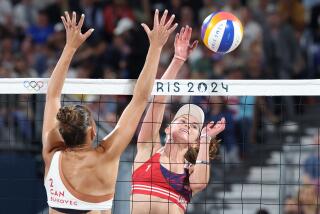A LOOK AT THE OTHER SPORTS : Post-Olympic Fortunes of U.S. Teams in Basketball, Gymnastics, Swimming, and Track and Field Are Well-Known; But what is the status of U.S. Teams in Lesser-known Sports? Here’s an Update : YACHTING : Team Floats Along During Buildup for America’s Cup
- Share via
Americans sailed in with three gold medals and four silvers in the seven Olympic classes at Long Beach last year, so surprising themselves that they almost fell overboard.
“It’s going to be a hell of a lot more difficult next time around,” says Jonathan Harley, director of the Olympic Yachting Committee of the United States Yacht Racing Union.
Not only is Korea on the other side of the world, but where sailing is concerned, it is another world.
The natives not only don’t drink the water. They don’t even sail on it. Recreational sailing is nil in Korea. The country had only one entry at Long Beach: Cho Jin Sup, who placed 34th in sailboards.
Americans also will lose the advantage, whatever there is, of sailing near home. They will also lose some of the energy that went into their eight-year effort, transcending the ’80 boycott, to the country’s effort toreclaim the America’s Cup at Australia in ’87.
Robbie Haines, who won the Soling class, has become executive director of USYRU, succeeding Tom Ehman, who transferred his title to the New York Yacht Club’s America II syndicate, which has Finn silver medalist John Bertrand as tactician. Rod Davis, who crewed for Haines, is skipper for the Newport Beach YC’s Eagle syndicate.
Among the other medalists--winners Bill Buchan, Star, and Jonathan McKee, Flying Dutchman, with Buchan’s son Carl as crew, and runners-up Steve Benjamin, 470; Scott Steele, sailboards, and Randy Smyth, Tornado--only Smyth and crew Jay Glaser seem to be pointing toward the ’88 Games in Korea.
Steele, whose silver was the biggest surprise, may have been legislated out of a comeback. Competition in ’88 will be on displacement boards instead of the light, flat ones the 130-pound Steele handled so well in light wind.
“We’re trying to identify new talent,” Harley said.
Part of that program is to find competitors in the new women’s 470 class and to generate interest in the Olympic boats that are generally ignored by American sailors.
In its development program headed by Sam Merrick, the OYC spent $993,000 sending its top prospects to international competitions in the years preceding the ’84 Games. Andy Kostanecki, the former Olympian who succeeded Merrick as chairman of the OYC, estimated that it may require twice that much for the U.S. to be competitive in ’88.
One sailor currently being funded is Russ Silvestri, the USC business student who was disqualified after placing first in the U.S. Finn class trials. Through an exhaustive appeals process, the winner changed six times before Bertrand won out two days before the first Olympic race, and the landmark case brought significant revisions in the yacht racing rules.
The ’88 Olympics will be sailed in the Eastern Sea, a 50-mile channel between South Korea and Japan. The base will be at Haeundae near the major seaport of Pusan, which is 200 miles southeast of Seoul.
The Koreans are building an Olympic sailing facility at a cost of 45 billion won. That’s about $58.5 million, a ton of won in any language.
“Knowing the Koreans,” Harley said, “it’s going to be a first-class facility.
More to Read
Go beyond the scoreboard
Get the latest on L.A.'s teams in the daily Sports Report newsletter.
You may occasionally receive promotional content from the Los Angeles Times.






